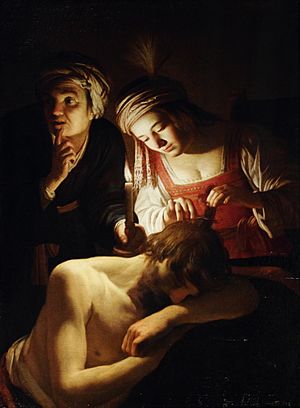Mon cœur s'ouvre à ta voix facts for kids

The song "Mon cœur s'ouvre à ta voix" is a famous part of the opera Samson and Delilah by Camille Saint-Saëns. It means "My heart opens to your voice" in French. This beautiful song is sung by a character named Delilah. She sings it in the second act of the opera. Delilah is trying to convince Samson to tell her the secret of his amazing strength.
Contents
About the Song
This special song is called an aria. An aria is a song for one singer, usually in an opera. The singer for this aria is a mezzo-soprano. This is a type of female singing voice that is lower than a soprano but higher than a contralto.
The Story Behind the Song
In the opera, Delilah is trying to trick Samson. She wants him to tell her the secret of his strength. Samson is very strong, and Delilah wants to find out why. She sings this aria to make him fall in love with her even more. She hopes he will then tell her his secret.
Samson tells Delilah, "Dalila! Dalila! Je t'aime!" (Delilah! Delilah! I love you!). He says this between the parts of her song. Sometimes, when the song is performed alone, Samson's words are left out. Or, a singer might change them to "Samson! Samson! Je t'aime!"
How the Music Works
The song is written in a musical key called D-flat major. The main part of the song has a time signature of 3/4. This means there are three quarter-note beats in each measure. The part where Delilah sings "Ah! réponds" changes to a 4/4 time signature. This means there are four quarter-note beats in each measure.
The speed of the song is called andantino. This means it is played at a moderately slow speed. The "Ah! réponds" part is a little slower.
Instruments in the Song
Many different instruments play along with Delilah's voice. These include the flute, oboe, clarinet, and horns. The harp and strings (like violins and cellos) also play.
The string instruments often play in a special way called divisi. This means the musicians in a section divide the notes. For example, the cellos might play four different notes at once.
The music for the first part of the song often has repeated notes. The second part has notes that move down in a smooth, connected way. The "Ah! réponds" part has notes that move up in a broken chord pattern.
Singing Challenges
This song is known for being challenging to sing. It has many notes for one syllable, which is called melisma. Singers need to connect these notes smoothly, which is called legato singing. They also need to sing over a wide range of notes.

